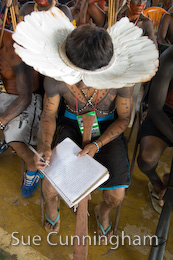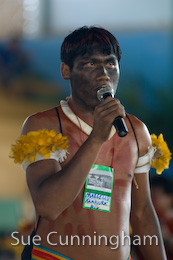My good intentions to upload to this blog each day were thwarted by the failure of the local internet. This post covers the fourth day of the Encontro Xingu.
 Day 4 saw legal matters discussed at length, covering the right of indigenous people to be consulted, and actions being taken as a result of the failure of Eletrobras to do so.
Day 4 saw legal matters discussed at length, covering the right of indigenous people to be consulted, and actions being taken as a result of the failure of Eletrobras to do so.
It included reference to the United Nations Convention 169, which relates to the rights of indigenous people to live and develop as differentiated peoples, in accordance with their own standards. More recently, Brazil heavily supported the United Nation’s Declaration on the Rights of Indigenous Peoples.
 Brazil joined another 142 nations of the world in voting for the declaration. Piragibe dos Santos Tarrago, Brazil’s representative, speaking on the day the Declaration was approved, said that Brazil welcomed the text. He said that Brazil’s indigenous peoples were crucial to the development of society at every level, and that Brazil would underscore that the exercise of the rights of indigenous peoples was consistent with the sovereignty and territorial integrity of the States in which they resided. At the same time, States should always bear in mind their duty to protect the rights and identity of their indigenous peoples, he added.
Brazil joined another 142 nations of the world in voting for the declaration. Piragibe dos Santos Tarrago, Brazil’s representative, speaking on the day the Declaration was approved, said that Brazil welcomed the text. He said that Brazil’s indigenous peoples were crucial to the development of society at every level, and that Brazil would underscore that the exercise of the rights of indigenous peoples was consistent with the sovereignty and territorial integrity of the States in which they resided. At the same time, States should always bear in mind their duty to protect the rights and identity of their indigenous peoples, he added.
Displacing indigenous communities from their long-established locations may appear benign, even on occasions beneficial.
 But those people have established a complex system of interraction with their environment. Their nutrition is based on fishing and hunting, which provide most of their protein, planting and harvesting, which provide most of their starch and carbohydrate, and collecting from the wild, which provides other essential nutrients including trace elements and vitamins.
But those people have established a complex system of interraction with their environment. Their nutrition is based on fishing and hunting, which provide most of their protein, planting and harvesting, which provide most of their starch and carbohydrate, and collecting from the wild, which provides other essential nutrients including trace elements and vitamins.
 Their relationship with the forest doesn’t stop there. They also harvest materials for building their houses and making tools and cultural items, such as body decorations, baskets and craft-work. They collect plants, roots, leaves, fruits, nuts and tree bark from which they make medicines. Many of these are found at some distance from the village, necessitating long expeditions to collect them; but the Indians have passed down the knowledge of their locations and uses through many generations, and they have become integral parts of their cultural heritage, and their intellectual property.
Their relationship with the forest doesn’t stop there. They also harvest materials for building their houses and making tools and cultural items, such as body decorations, baskets and craft-work. They collect plants, roots, leaves, fruits, nuts and tree bark from which they make medicines. Many of these are found at some distance from the village, necessitating long expeditions to collect them; but the Indians have passed down the knowledge of their locations and uses through many generations, and they have become integral parts of their cultural heritage, and their intellectual property.
Many villages are strategically placed to take advantage of more than one kind of ecosystem. For example, the community may make use of materials from the rainforest and from drier cerrados areas. They may fish for some species in the river, and others in the lakes.
What most indigenous communities have in common, which continues to the present day, is that they do not rely on money to provide for their everyday needs. Money is still alien to them – they call it ‘dead leaves’ – and is only used to purchase the occasional manufactured items they use.
 If you take this community and uproot the people from their location at the side of a flowing river and relocate them in another place, their entire cultural heritage becomes irrelevant to their everyday lives. They no longer know where to find the right kinds of food, they can no longer treat the diseases that were conquered by their ancestors generations in the past, and they can no longer house or feed themselves. They become reliant on food or money provided by the mainstream society, which may be provided only for a short time, and will always provide only the most basic level of nutrition and subsistence. Housing is constructed for them using alien materials, and is usually built in an alien form, further distancing them from their way of life and cultural self-expression.
If you take this community and uproot the people from their location at the side of a flowing river and relocate them in another place, their entire cultural heritage becomes irrelevant to their everyday lives. They no longer know where to find the right kinds of food, they can no longer treat the diseases that were conquered by their ancestors generations in the past, and they can no longer house or feed themselves. They become reliant on food or money provided by the mainstream society, which may be provided only for a short time, and will always provide only the most basic level of nutrition and subsistence. Housing is constructed for them using alien materials, and is usually built in an alien form, further distancing them from their way of life and cultural self-expression.
Even if the community is not physically removed, it can still suffer cultural debasement because of changes in the environment imposed, deliberately or unthinkingly, by people outside of the indigenous reserve. This is the situation in the upper Xingu, where the dams on the headwaters threaten the food supplies of the fourteen tribes living in the Xingu Indigenous Park.
 This action can only be described as cultural annihilation. It is diametrically at odds to Brazil’s words and commitments as expressed in the United Nations Declaration. There can simply be no justification, no explanation, no cost-benefit analysis which can justify such a complete abrogation of the country’s commitments, freely entered into and enthusiastically endorsed.
This action can only be described as cultural annihilation. It is diametrically at odds to Brazil’s words and commitments as expressed in the United Nations Declaration. There can simply be no justification, no explanation, no cost-benefit analysis which can justify such a complete abrogation of the country’s commitments, freely entered into and enthusiastically endorsed.
Back in the hall where the Encontro Xingu was drawing towards its close, when the speakers had each given their presentations, the Indians took control of the meeting. Each chief in turn came to the table, explained the source of his authority, and stated his community’s position. Without exception, the statement said, clerly and forcefully, “We do not want the government to build any dams on the Xingu.”
 The presentations were calm and dignified. Each chief spoke briefly, directly to the Public Prosecutor. Some spoke in Portuguese, some spoke through an interpreter. Many asked him for his help. Some spoke about the Brazilian constitution; some reminded him that they too are Brazilians, in fact that they are the first Brazilians. Each chief then shook the Public Prosecutor’s hand and thanked him.
The presentations were calm and dignified. Each chief spoke briefly, directly to the Public Prosecutor. Some spoke in Portuguese, some spoke through an interpreter. Many asked him for his help. Some spoke about the Brazilian constitution; some reminded him that they too are Brazilians, in fact that they are the first Brazilians. Each chief then shook the Public Prosecutor’s hand and thanked him.
They demonstrated that they respect and accept the Brazilian mainstream culture. They even went as far as to sing the Brazilian National Anthem in the Kayapo Language. Now the Brazilian mainstream must show them that this respect is mutual.
The Day 4 picture gallery is here:
http://pa.photoshelter.com/c/scp/gallery-show/G0000dJRsGDf1JTQ/
© Patrick Cunningham

































